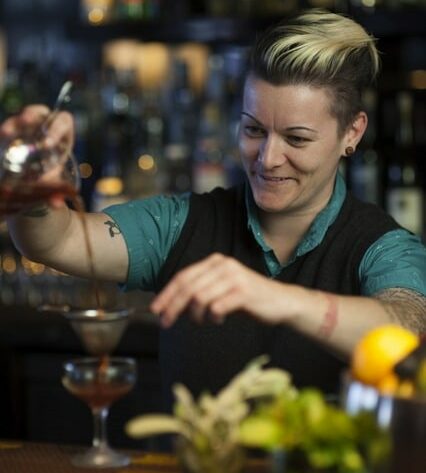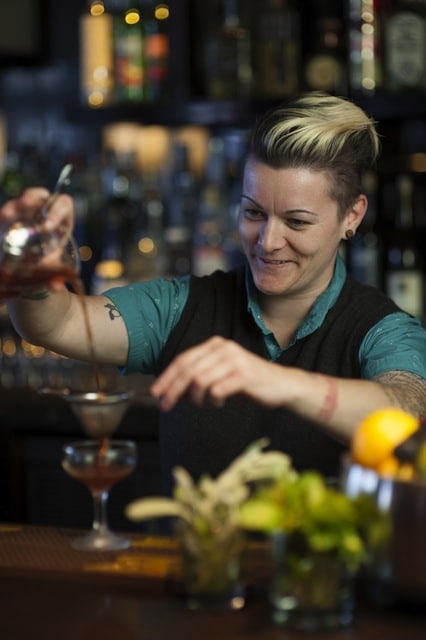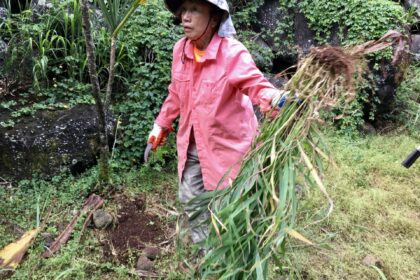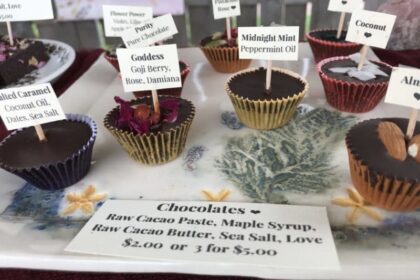
Mezcal. If you’re like me a couple weeks ago, the word didn’t call anything to mind besides “it sounds vaguely familiar…” If you’re a little worldlier, you might recognize it as a type of alcohol, maybe even mistakenly associate it with tequila. Or wrongly envision it as a shady, unregulated Mexican bootleg beverage, smuggled in gourds over the border. Fortunately, I met Jen Queen, the 14th person to earn the title “Master Mezcalier” worldwide, who straightened out these misconceptions while sharing her love of this versatile drink.
What Is This Liquor?
Mezcal is a double-distilled alcoholic beverage made from mashed, fermented agave plants native to Mexico. Unlike the rest of the world, in Mexico the drink has a religious and almost magical reputation. Even before indigenous people learned to distill the agave plant, they revered agave as the source of food, firewood, medicine, building materials and fiber for cloth and rope. If left alone, its juice ferments into an alcoholic pulp. Anthropologists believe that indigenous people started boiling this pulp during religious ceremonies, covering the boiling pot with a cotton cloth, which they wrung out to retrieve the precious liquor.
As technology developed, they started using clay jugs with bamboo condensation systems and word about this delicious spirit spread. Nineteenth century colonial aristocrats dubbed the drink the “Mexican Cognac” because of its exquisite and delicious flavors.
Tequila is also made from the agave succulent; however, mezcal must be 100% agave whereas tequila can contain as little as 51%. Mezcal has a more smoky and savory taste than tequila, which often surprises drinkers.
“A lot of people don’t expect the smoke or the aggression of mezcal,” explains Jen. “It’s also higher proof than tequila. That’s why in Oaxaca, they tell you to treat mezcal softly.”
Mezcal deserves respect for more than just alcohol content- it is not a cheap or easy to produce product. It takes a decade to just grow the harvest. The process of making mezcal isn’t industrialized, so the agave is still hand-crushed and closely supervised through every step — including harvesting, roasting and distilling the alcohol. Although mezcal is handmade, the Mexican government regulates the production and quality through the Consejo Regulador de Mezcal (CRM) and COMERCAM (Consejo Mexicano).
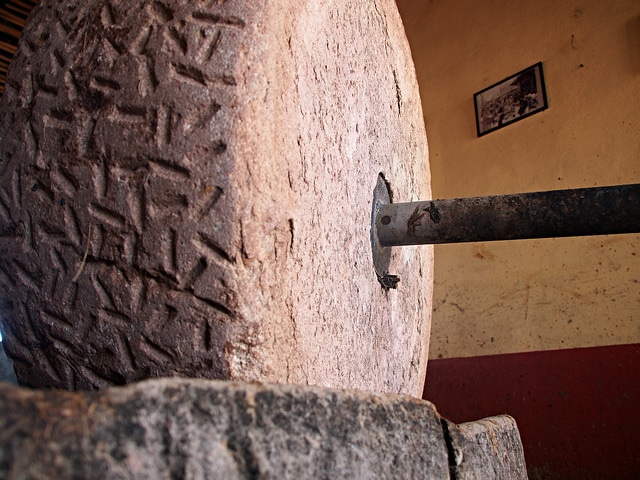
Jen’s Mission
Since a maze of misconceptions surrounds this mysterious beverage, Jen hopes to change the way people outside Mexico view mezcal. If you visit her at San Diego’s Saltbox Restaurant & Cocktail Lounge where she works as a principal bartender, she likes to sneakily convert self-described mezcal-haters into fans.
“I usually start with a conversation about what you like to drink and relate the flavors I find in each mezcal to the flavors you tell me you enjoy,” says Jen.
Since there are 27 varietals produced in eight different states in Mexico, she has quite the palate to choose from. Then, she concocts cocktails to appease a customer’s palate while showcasing mezcal as the centerpiece of the recipe. She modifies classic cocktails like the “Penicillin” using tequila instead of blended scotch, so it’s soft, with ginger, honey, citrus and a smoky mezcal float instead of an Islay scotch (recipe below).
With her creative and handcrafted creations, she is often successful in changing people’s minds, even appeasing gin lovers with mezcals with bold, aromatic notes.
She declares, “Mezcal is often the kid you thought you hated, who later becomes your best friend. I really love watching that happen”.
The Mezcal Mastermind
Jen’s love affair with mezcal began when she moved from Columbus, Ohio to San Francisco, California and landed a bartending gig at Tres Agaves (now called Tres). In this bar — co-owned by Julio Bermejo, one of Mexico’s tequila ambassadors — she developed a deep appreciation for both tequila and mezcal. On a tasting panel at Spirits of Mexico Festival in San Diego, Jen learned about the Master Mezcalier certification through its creator Doug French. The program appealed to Jen as a way to further her relationship with mezcal and achieve expert status.
“I know enough about spirits in general to know that I will never know enough about spirits, in general,” she says. “Chasing this certification began in educating myself and it absolutely inspires me to continue learning about every category.”
To earn the elite title, Jen studied for three years to advance through four ascending levels of understanding about characteristics of agaves and the history of mezcal production. Jen devoted countless trips to Oaxaca, Mexico to participate in the process herself. As the leading producer of this alcohol made from agave, Oaxaca is known as “Capital Mundial Del Mezcal”- the world capital of mezcal. There, Jen studied all she could about this labor-intensive product and participated in all aspects from growing to harvesting.
She recalls, “I have a trust in mezcal after witnessing production first hand, and a huge respect for the work and love in the bottle. Oaxaca went straight to my heart.”
She passed challenges such as blind tasting, food pairing and even inventing and executing a dish featuring mezcal as a primary ingredient.
The Future
Jen is optimistic about the future of mezcal, citing its increasing popularity on cocktail menus and in liquor stores.
She adds enthusiastically, “The thing that impresses me the most is that some brands are reaching out to bartenders and asking what we want. Del Maguey Vida is made for bartenders with cocktails in mind. I hope other spirits start to follow and give us some fun new toys to play with.”
And play she will. Queen has already put her expertise to good use on Saltbox’s new menu, crafting cocktails that highlight agave spirits. If you aren’t lucky enough to visit the charming Jen Queen in San Diego yourself, experiment with her favorite concoctions to see if she can change your mind about “the kid you thought you hated.” The “Mexican Monk” features the organic Del Maguey Vida, the mezcal “made for cocktails”. The “Potavikin” is Jen’s riff on the classic cocktail “The Penicillin,” mentioned above.

Recipes
Potavikin
Jen Queen, Principal Bartender, Saltbox Dining & Drinking
Ingredients
2 oz. Fortaleza Reposado Tequila
3/4 oz. lime juice
3/4 oz. ginger-honey syrup
1/4 oz. Los Nahuales Anejo Mezcal
Candied ginger
Directions
Combine tequila, lime juice and ginger-honey syrup in a cocktail shaker filled with ice. Shake to chill. Strain into a double Old Fashioned glass over a large ice cube. Gently pour mezcal over the top of the drink to float. Garnish with candied ginger.
Ginger-Honey Syrup:
1 cup sugar
1 cup water
1/2 cup honey
1 lb. fresh ginger, peeled and juiced
Directions
Combine sugar, water and honey in a small saucepan and bring to a boil. Let cool and which in ginger juice. Ingredients can be adjusted to taste.
Mexican Monk
Jen Queen, Principal Bartender, Saltbox Dining & Drinking
Ingredients
1.25 oz. Del Maguey Vida
.5 oz. Yellow Chartreuse
.25 oz. Luxardo Maraschino
1 dash peach bitters
2 dashes Angostura bitters
Directions
Add ingredients to a mixing glass. Stir and strain into an Old Fashioned glass over a large ice cube. Garnish with a lemon peel expressed and inserted.
Katie Foote
Latest posts by Katie Foote (see all)
- 8 Outstanding Conservation Safaris Around The World - Apr 12, 2022
- These 10 Women Whiskey Distillers Will Make You Crave A Manhattan - Dec 12, 2018
- Ethical Travel: Should You Visit Thailand’s Long Neck Women Villages? - Dec 9, 2018
- 8 Pioneering Vegetarian Vacations Around The World - Aug 13, 2018
- A New Perspective: Can Travel Help Reverse Alzheimer’s? - Aug 5, 2018

